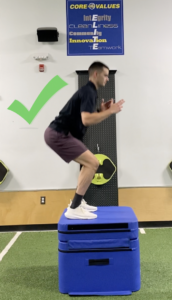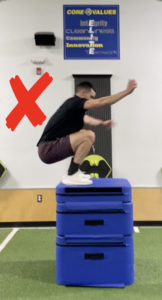Breaking Down the Box Jump
The box jump exercise is one of the staples of our Sports Performance training programs here at Elite. It’s a simple but effective exercise for building lower body power and explosiveness while also teaching proper landing mechanics. However, just like any exercise, form and technique are important when trying to get the most benefit from this exercise while also preventing unnecessary stress on joints, ligaments, and tendons.
One common misconception we often encounter is an athlete focusing too much on the height of the box over optimal form. In fact, the height of the box matters very little – it’s how high the athlete is jumping that counts! The box is simply there to help reduce the effects of gravity and the resulting forces on the athlete when landing. That’s the real beauty and value of the box jump – it allows the athlete to work on generating maximum power and height while minimizing the stress of landing. This is why we always begin our lower-body power training with box jumps to ensure excellent form and landing mechanics before transitioning an athlete to more advanced and challenging plyometric exercises later in the program. In addition to traditional double-leg box jumps, our athletes also perform other variations, including lateral, medial, and single leg versions. As with all of our exercises, our athletes work on building a strong foundation by mastering the basics before moving on to more advanced exercises.
Here are some key points to perform a good box jump:
- Always perform a comprehensive dynamic warm up program prior to performing an explosive power exercise such as a box jump.
- Start with your feet shoulder-width apart and a slight bend in your knees, with your head and chest up
- Perform a quick hip hinge to descend into a quarter-squat position, then quickly explode upward into the jump (as we often cue our athletes, “jump as high as you can, not just to the height of the box.” Remember, the box is only there to reduce the effects of gravity upon landing!)
- Try to land as quietly and softly as you can and in the same quarter-squat position that you jumped from. Be careful to make sure your knees stay aligned with your feet and don’t cave inward upon landing!)
- Key point: If you can’t land softly and quietly in a quarter-squat position, but instead land in a position with your hips, knees, ankles and lumbar spine in a flexed position (see photo), the box height is TOO HIGH and you may be putting unnecessary stress through your hips, knees, ankles and lumbar spine. Remember, it’s not the height of the box that matters…it’s how high you’re jumping!
- Finally, step off the box instead of jumping of the box and get ready to perform your next jump.


We hope these tips helped explain why we love box jumps so much, why we focus so much on proper form, and why they’re such a beneficial exercise in any strength and conditioning program!
If you or an athlete in your family would like to join the Elite Sports Performance community, Elite Sports Performance & Physical Therapy offers Sports Performance and Athlete Training programs at both our Foxboro and Stoughton locations. To learn more about our programs for athletes of all ages and sports and how YOU can perform the perfect box jump (and many other exercises!) and improve your strength, power and performance in the process, click HERE or email us at EliteSPC@EliteFitCenter.com!
